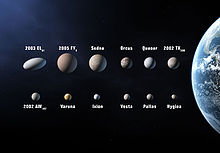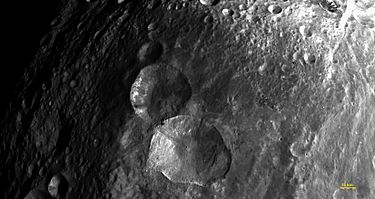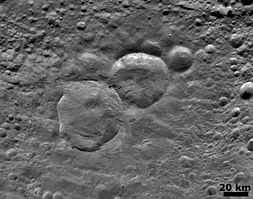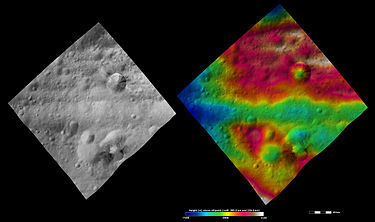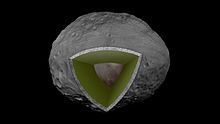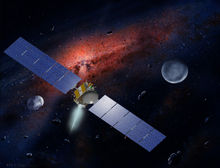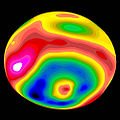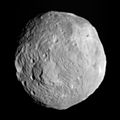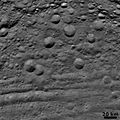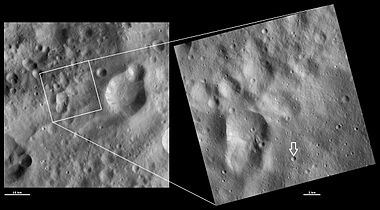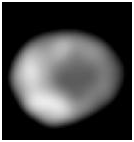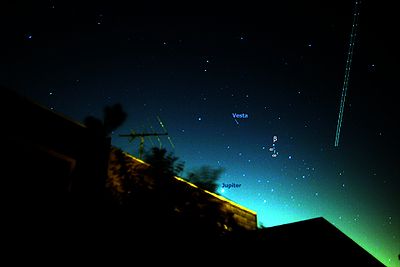
4 Vesta
Background Information
SOS Children has tried to make Wikipedia content more accessible by this schools selection. Click here for more information on SOS Children.
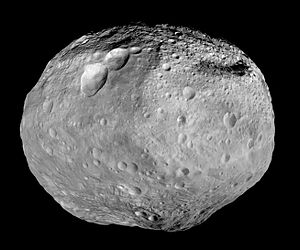 Composite Dawn spacecraft image of Vesta. Rheasilvia crater, with its massive central peak, covers much of the southern hemisphere (bottom); the 'snowman' craters are near the top left. Saturnalia Fossa runs obliquely near the terminator at upper right, with nearby grooves parallel to it. |
|
| Discovery | |
|---|---|
| Discovered by | Heinrich Wilhelm Olbers |
| Discovery date | 29 March 1807 |
| Designations | |
| Pronunciation | / ˈ v ɛ s t ə / |
| Named after | Vesta |
| Minor planet category | Main belt ( Vesta family) |
| Adjective | Vestan, Vestian |
| Orbital characteristics | |
| Epoch 2010-Jul-23 ( JD 2455400.5) | |
| Aphelion | 2.571 AU (384.72 Gm) |
| Perihelion | 2.1526 AU (321.82 Gm) |
| Semi-major axis | 2.362 AU (353.268 Gm) |
| Eccentricity | 0.088 62 |
| Orbital period | 3.63 a (1325.85 d) |
| Average orbital speed | 19.34 km/s |
| Mean anomaly | 307.80° |
| Inclination | 7.134° to Ecliptic 5.56° to Invariable plane |
| Longitude of ascending node | 103.91° |
| Argument of perihelion | 149.84° |
| Proper orbital elements | |
| Proper semi-major axis | 2.3615126 AU |
| Proper eccentricity | 0.0987580 |
| Proper inclination | 6.3923416° |
| Proper mean motion | 99.188833 deg / yr |
| Proper orbital period | 3.62944 yr (1325.653 d) |
| Precession of perihelion | 36.872897 arcsec / yr |
| Precession of the ascending node | −39.597863 arcsec / yr |
| Physical characteristics | |
| Dimensions | (572.6×557.2×446.4)±0.2 km 525.4±0.2 km ( mean) |
| Mass | 2.59076±0.00001×1020 kg |
| Mean density | 3.456 g/cm³ |
| Equatorial surface gravity | 0.25 m/s2 0.025 g |
| Escape velocity | 0.36 km/s |
| Rotation period | 0.222 6 d (5.342 h) |
| Albedo | 0.423 ( geometric) |
| Temperature | min: 85 K (−188 °C) max: 270 K (−3 °C) |
| Spectral type | V-type asteroid |
| Apparent magnitude | 5.1 to 8.48 |
| Absolute magnitude (H) | 3.20 |
| Angular diameter | 0.70" to 0.22" |
|
|
|
Vesta, minor-planet designation 4 Vesta, is one of the largest asteroids in the Solar System, with a mean diameter of 525 kilometres (326 mi). It was discovered by Heinrich Wilhelm Olbers on 29 March 1807, and is named after Vesta, the virgin goddess of home and hearth from Roman mythology.
Vesta is the second-most-massive asteroid after the dwarf planet Ceres, and comprises an estimated 9% of the mass of the asteroid belt. The less-massive Pallas is slightly larger, making Vesta third in volume. Vesta is the last remaining rocky protoplanet (with a differentiated interior) of the kind that formed the terrestrial planets. It lost some 1% of its mass less than a billion years ago in a collision that left an enormous crater occupying much of its southern hemisphere. Debris from this event has fallen to Earth as howardite–eucrite–diogenite (HED) meteorites, a rich source of information about the asteroid.
Vesta is the brightest asteroid visible from Earth. Its maximum distance from the Sun is slightly farther than the minimum distance of Ceres from the Sun, though its orbit lies entirely within the Cererian orbit.
NASA's Dawn spacecraft entered orbit around Vesta on 16 July 2011 for a one-year exploration, and what is known about Vesta will be refined and extended as data from Dawn is analyzed and published. Dawn left Vestan orbit on 5 September 2012.
Discovery
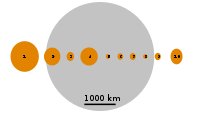
Heinrich Olbers discovered Pallas in 1802, the year after the discovery of Ceres. He proposed that the two objects were the remnants of a destroyed planet. He sent a letter with his proposal to the English astronomer William Herschel, suggesting that a search near the locations where the orbits of Ceres and Pallas intersected might reveal more fragments. These orbital intersections were located in the constellations of Cetus and Virgo. Olbers commenced his search in 1802, and on 29 March 1807 he discovered Vesta in the constellation Virgo — a coincidence, as Ceres, Pallas, and Vesta are not fragments of a larger body. As the asteroid Juno had been discovered in 1804, this made Vesta the fourth object to be identified in the region that is now known as the asteroid belt. The discovery was announced in a letter addressed to German astronomer Johann H. Schröter dated 31 March. Because Olbers already had credit for discovering a planet, Pallas (at the time, the asteroids were considered to be planets), he gave the honour of naming his new discovery to German mathematician Carl Friedrich Gauss, whose orbital calculations had enabled astronomers to confirm the existence of Ceres, the first asteroid, and who had computed the orbit of the new planet in the remarkably short time of 10 hours. Gauss decided on the Roman virgin goddess of home and hearth, Vesta.
Name
Vesta was the fourth asteroid to be discovered, hence the number 4 in its formal designation. The name Vesta, or national variants thereof, is in international use with two exceptions: Greece and China. In Greek the name adopted was the Hellenic equivalent of Vesta, Hestia (4 Εστία); in English, that name is used for 46 Hestia (Greeks use the name "Hestia" for both, with the asteroid numbers used for disambiguation). In Chinese, Vesta is called the 'hearth-god(dess) star', 灶神星 zàoshénxīng, in contrast to the goddess Vesta, who goes by her Latin name.
When Olbers discovered Vesta, Ceres, Pallas, and Juno were classified as planets and each had its own planetary symbol. Vesta was likewise classified as a planet, and along with its name, Gauss designed an appropriate planetary symbol, ⚶, the altar of Vesta with its sacred fire. In Gauss's conception this was drawn ![]() ; in its modern form it is
; in its modern form it is ![]() .
.
After the discovery of Vesta, no further objects were discovered for 38 years, and the Solar System was thought to have eleven planets. However, in 1845 new asteroids started being discovered at a rapid pace, and by 1851 there were fifteen, each with its own symbol, in addition to the seven major planets. It soon became clear that it would be impractical to continue inventing new planetary symbols indefinitely, and some of the existing ones proved difficult to draw quickly. That year the problem was addressed by Benjamin Apthorp Gould, who suggested numbering asteroids in their order of discovery, and placing this number in a disk (circle) as the generic symbol of an asteroid. Thus the fourth asteroid, Vesta, acquired the generic symbol ④. This was soon coupled with the name into an official number–name designation, ④ Vesta, as the number of minor planets increased. By 1858, the circle had been simplified to parentheses, (4) and (4) Vesta, which was easier to typeset. Other punctuation such as 4) Vesta and 4, Vesta was also used, but had more or less completely died out by 1949. Today either Vesta or more commonly 4 Vesta is used.
Early measurements
Photometric observations of the asteroid Vesta were made at the Harvard College Observatory in 1880–1882 and at the Observatoire de Toulouse in 1909. These and other observations allowed the rotation rate of the asteroid to be determined by the 1950s. However, the early estimates of the rotation rate came into question because the light curve included variations in both shape and albedo.
Early estimates of the diameter of Vesta ranged from 383 (in 1825) to 444 km. E.C. Pickering produced an estimated diameter of 513 ± 17 km in 1879, which is close to the modern value for the mean diameter, but the subsequent estimates ranged from a low of 390 km up to a high of 602 km during the next century. The measured estimates were based on photometry. In 1989, speckle interferometry was used to measure a dimension that varied between 498 and 548 km during the rotational period. In 1991, an occultation of the star SAO 93228 by Vesta was observed from multiple locations in the eastern United States and Canada. Based on observations from 14 different sites, the best fit to the data is an elliptical profile with dimensions of about 550 km × 462 km.
Vesta became the first asteroid to have its mass determined. Every 18 years, the asteroid 197 Arete approaches within 0.04 AU of Vesta. In 1966, based upon observations of Vesta's gravitational perturbations of Arete, Hans G. Hertz estimated the mass of Vesta as (1.20 ± 0.08) × 10−10 solar masses. More refined estimates followed, and in 2001 the perturbations of 17 Thetis were used to estimate the mass of Vesta as (1.31 ± 0.02) × 10−10 solar masses.
Physical characteristics
Vesta is the second-most-massive body in the asteroid belt, though only 28% as massive as Ceres. The surface area is approximately the same as that of Pakistan. Vesta orbits in the inner asteroid belt interior to the Kirkwood gap at 2.50 AU. It has a differentiated interior, and is similar to 2 Pallas in volume (to within uncertainty) but about 25% more massive.
Vesta's shape is close to a gravitationally relaxed oblate spheroid, but the large concavity and protrusion at the southern pole (see 'Surface features' below) combined with a mass less than 5×1020 kg precluded Vesta from automatically being considered a dwarf planet under International Astronomical Union (IAU) Resolution XXVI 5. Vesta may be listed as a dwarf planet in the future, if it is convincingly determined that its shape, other than the large impact basin at the southern pole, is due to hydrostatic equilibrium.
Its rotation is relatively fast for an asteroid (5.342 h) and prograde, with the north pole pointing in the direction of right ascension 20 h 32 min, declination +48° (in the constellation Cygnus) with an uncertainty of about 10°. This gives an axial tilt of 29°.
Temperatures on the surface have been estimated to lie between about −20 °C with the Sun overhead, dropping to about −190 °C at the winter pole. Typical daytime and nighttime temperatures are −60 °C and −130 °C, respectively. This estimate is for 6 May 1996, very close to perihelion, while details vary somewhat with the seasons.
Surface features
Prior to the arrival of the Dawn spacecraft, some Vestan surface features had already been resolved using the Hubble Space Telescope and ground-based telescopes (e.g. the Keck Observatory).
Rheasilvia crater
The most prominent of these surface features is an enormous crater 505 kilometres (314 mi) in diameter centered near the south pole. The Dawn science team has named it Rheasilvia, after the mother of Romulus and Remus and a mythical vestal virgin. Its width is 90% the diameter of Vesta. The floor of this crater is about 13 kilometres (8.1 mi) below, and its rim rises 4–12 km above the surrounding terrain, with total surface relief of about 25 km. A central peak rises 23 km above the lowest measured part of the crater floor and the highest measured part of the crater rim is 31 km above the crater floor low point. It is estimated that the impact responsible excavated about 1% of the volume of Vesta, and it is likely that the Vesta family and V-type asteroids are the products of this collision. If this is the case, then the fact that 10-km fragments have survived bombardment until the present indicates that the crater is at most only about 1 billion years old. It would also be the original site of origin of the HED meteorites. In fact, all the known V-type asteroids taken together account for only about 6% of the ejected volume, with the rest presumably either in small fragments, ejected by approaching the 3:1 Kirkwood gap, or perturbed away by the Yarkovsky effect or radiation pressure. Spectroscopic analyses of the Hubble images have shown that this crater has penetrated deep through several distinct layers of the crust, and possibly into the mantle, as indicated by spectral signatures of olivine.
The large massif at the centre of Rheasilvia is 20 to 25 kilometres (12–16 mi) high and 180 kilometres (110 mi) wide. The crater overlies an older one, Veneneia, that at 395 kilometres (245 mi) across is almost as large.
Other craters
Several large craters about 150 kilometres (93 mi) wide and 7 kilometres (4.3 mi) deep are also present. A dark albedo feature about 200 kilometres (120 mi) across has been named Olbers in honour of Vesta's discoverer, but it does not appear in elevation maps as a fresh crater would. Its nature is presently unknown; it may be an old basaltic surface. It serves as the reference point for one of two competing prime meridians proposed for Vesta. The other is centered on the small crater Claudia.
- "Snowman craters"
The "snowman craters" is an informal name given to a group of three adjacent craters in Vesta's northern hemisphere. Their official names from largest to smallest (west to east) are Marcia, Calpurnia and Minucia.
Troughs
The majority of the equatorial region of Vesta is sculpted by a series of concentric troughs, such as Divalia Fossa (10–20 km wide, 465 km long), which encircles the equator. A second series, inclined to the equator, such as Saturnalia Fossa (≈ 40 km wide, > 370 km long), is found further north. These are thought to be large-scale fractures resulting from the impacts that created Rheasilvia and Veneneia craters, respectively. They are some of the longest chasms in the Solar System, nearly as long as Ithaca Chasma on Tethys. The troughs may have formed after another asteroid collided with Vesta and be graben.
Geology
There is a large collection of potential samples from Vesta accessible to scientists, in the form of over 200 HED meteorites, giving insight into Vesta's geologic history and structure. NASA Infrared Telescope Facility (NASA IRTF) studies of asteroid (237442) 1999 TA10 suggest that it originated from the interior of Vesta.
Vesta is thought to consist of a metallic iron–nickel core 214–226 km in diameter, an overlying rocky olivine mantle, with a surface crust. From the first appearance of Ca–Al-rich inclusions (the first solid matter in the Solar System, forming about 4.567 billion years ago), a likely time line is as follows:
-
Timeline of the evolution of Vesta 2–3 million years Accretion completed 4–5 million years Complete or almost complete melting due to radioactive decay of 26Al, leading to separation of the metal core 6–7 million years Progressive crystallization of a convecting molten mantle. Convection stopped when about 80% of the material had crystallized Extrusion of the remaining molten material to form the crust, either as basaltic lavas in progressive eruptions, or possibly forming a short-lived magma ocean. The deeper layers of the crust crystallize to form plutonic rocks, while older basalts are metamorphosed due to the pressure of newer surface layers. Slow cooling of the interior
Vesta is the only known intact asteroid that has been resurfaced in this manner. Because of this, some scientists refer to Vesta as a protoplanet. However, the presence of iron meteorites and achondritic meteorite classes without identified parent bodies indicates that there once were other differentiated planetesimals with igneous histories, which have since been shattered by impacts.
-
Composition of the Vestan crust (by depth) A lithified regolith, the source of howardites and brecciated eucrites. Basaltic lava flows, a source of non-cumulate eucrites. Plutonic rocks consisting of pyroxene, pigeonite and plagioclase, the source of cumulate eucrites. Plutonic rocks rich in orthopyroxene with large grain sizes, the source of diogenites.
On the basis of the sizes of V-type asteroids (thought to be pieces of Vesta's crust ejected during large impacts), and the depth of Rheasilvia crater (see below), the crust is thought to be roughly 10 kilometres (6 mi) thick. Findings from the NASA Dawn spacecraft have found evidence that the troughs that wrap around the asteroid could be dropped-off terrain from faults, making Vesta have a more complex geology than other asteroids. Vesta could have been classified as a dwarf planet if it had retained a spherical shape, and it has other qualities that lead to the belief it could be a protoplanet. The only thing that knocked it out of the category of a dwarf was a large collision near its southern pole; Vesta is no longer warm and plastic enough to return to hydrostatic equilibrium. The collision might be the reason that the troughs formed because of the high rotational-speed change that Vesta underwent as a result of the collision. Vesta is a one-seventh the size of the Moon and has a trough that dwarfs the Grand Canyon with a length of 465 kilometres (290 mi), a width of 22 kilometres (14 mi) and a depth of 5 kilometres (3 mi).
Scientists have found that Vesta has a crust, a mantle, and a core, a structure only present in larger bodies like planets and large moons. Scientists have been puzzled at how the troughs of Vesta were formed because of how complex they are. Some of the troughs could have been formed by a collision but findings from Dawn's images of Vesta's topography show that the only way these troughs could form is if the body that hit Vesta was differentiated, like Vesta itself. This has led scientists to consider Vesta a protoplanet.
Soil
Vesta's surface is covered by regolith distinct from that found on the Moon or asteroids such as Itokawa. This is because space weathering acts differently. Vesta's surface shows no significant trace of nanophase iron because the impact speeds on Vesta are too low to make rock melting and vaporization an appreciable process. Instead, regolith evolution is dominated by brecciation and subsequent mixing of bright and dark components. The dark component is probably due to the infall of carbonaceous material, whereas the bright component is the original Vesta basaltic soil.
Fragments
Some small Solar System bodies are believed to be fragments of Vesta caused by collisions. The Vestian asteroids and HED meteorites are examples. The V-type asteroid 1929 Kollaa has been determined to have a composition akin to cumulate eucrite meteorites, indicating its origin deep within Vesta's crust.
Vesta is currently one of only six identified Solar System bodies for which we have physical samples, coming from a number of meteorites believed to be Vestan fragments. The other identified Solar System samples are from Earth itself, meteorites from Mars, and samples returned from Earth's Moon, the comet Wild 2, and the asteroid 25143 Itokawa.
Exploration
In 1981, a proposal for an asteroid mission was submitted to the European Space Agency (ESA). Named the Asteroidal Gravity Optical and Radar Analysis (AGORA), this spacecraft was to launch some time in 1990–1994 and perform two flybys of large asteroids. The preferred target for this mission was Vesta. AGORA would reach the asteroid belt either by a gravitational slingshot trajectory past Mars or by means of a small ion engine. However, the proposal was refused by the ESA. A joint NASA–ESA asteroid mission was then drawn up for a Multiple Asteroid Orbiter with Solar Electric Propulsion (MAOSEP), with one of the mission profiles including an orbit of Vesta. NASA indicated they were not interested in an asteroid mission. Instead, the ESA set up a technological study of a spacecraft with an ion drive. Other missions to the asteroid belt were proposed in the 1980s by France, Germany, Italy and the United States, but none were approved. Exploration of Vesta by fly-by and impacting penetrator was the second main target of the first plan of the multiaimed Soviet Vesta mission, developed in cooperation with European countries for realisation in 1991–1994 but canceled due to the Soviet Union disbanding.
In the early 1990s, NASA initiated the Discovery Program, which was intended to be a series of low-cost scientific missions. In 1996, the program's study team recommended as a high priority a mission to explore the asteroid belt using a spacecraft with an ion engine. Funding for this program remained problematic for several years, but by 2004 the Dawn vehicle had passed its critical design review.
It launched on 27 September 2007, as the first space mission to Vesta. On 3 May 2011, Dawn acquired its first targeting image 1.2 million kilometers from Vesta. On 16 July 2011, NASA confirmed that it received telemetry from Dawn indicating that the spacecraft successfully entered Vesta's orbit. It was scheduled to orbit the asteroid for one year, until July 2012. Dawn's arrival coincided with late summer in the southern hemisphere of Vesta, with the large crater at Vesta's south pole ( Rheasilvia) in sunlight. Because a season on Vesta lasts eleven months, the northern hemisphere, including anticipated compression fractures opposite the crater, would become visible to Dawn's cameras before it left orbit. Dawn left orbit around Vesta on 4 September 2012 11:26 p.m. PDT to travel to Ceres.
NASA/DRL released imagery and summary information from a high-altitude orbit, including a two-minute video, in September 2011. Much more detailed imagery was planned to be obtained, from a lower orbit, beginning in October 2011.
Scientists will use Dawn to calculate Vesta's precise mass based on gravitational interactions. This will allow scientists to refine the mass estimates of the asteroids that are in turn perturbed by Vesta.
Observations from Earth orbit
-
Albedo and spectral maps of 4 Vesta, as determined from Hubble Space Telescope images from November 1994
-
Elevation diagram of 4 Vesta (as determined from Hubble Space Telescope images of May 1996) viewed from the south-east, showing Rheasilvia crater and an unnamed basin
-
Vesta seen by the Hubble Space Telescope in May 2007
Observations from Dawn
Vesta comes into view as the Dawn spacecraft approaches and enters orbit:
Coordinate controversy
There are two longitudinal coordinate systems in use for Vesta, with prime meridians separated by 155°. The IAU established a coordinate system in 1997 based on Hubble photos, with the prime meridian running through the centre of Olbers Regio, a dark feature 200 km across. When Dawn arrived at Vesta, mission scientists found that the location of the pole assumed by the IAU was off by 10°, and also that Olbers Regio was not discernible from up close, and so was not adequate to define the prime meridian with the precision they needed. They corrected the pole, but also established a new prime meridian relative to the centre of Claudia, a sharply defined crater 700 meters across, which they say results in a more logical set of mapping quadrangles. All NASA publications, including images and maps of Vesta, use the Claudian meridian, which is unacceptable to the IAU. Data published by the Gazetteer of Planetary Nomenclature, a branch of the IAU, uses the Claudian coordinate system as well, and notes that it has not been approved by the IAU. Michael A’Hearn, a member of the IAU working group in charge of the NASA database that will make Dawn data available to the public, insists that the data use an IAU-sanctioned coordinate system. He has suggested that a third system, correcting the pole and rotating the Claudian longitude by 155° to coincide with Olbers Regio, would be acceptable to the IAU.
Visibility
Its size and unusually bright surface make Vesta the brightest asteroid, and it is occasionally visible to the naked eye from dark skies (without light pollution). In May and June 2007, Vesta reached a peak magnitude of +5.4, the brightest since 1989. At that time, opposition and perihelion were only a few weeks apart.
Less favorable oppositions during late autumn 2008 in the Northern Hemisphere still had Vesta at a magnitude of from +6.5 to +7.3. Even when in conjunction with the Sun, Vesta will have a magnitude around +8.5; thus from a pollution-free sky it can be observed with binoculars even at elongations much smaller than near opposition.
2010–2011
In 2010, Vesta reached opposition in the constellation of Leo on the night of 17–18 February, at about magnitude 6.1, a brightness that makes it visible in binocular range but not for the naked eye. Under perfect dark sky conditions where all light pollution is absent it might be visible to an experienced observer without the use of a telescope or binoculars. Vesta came to opposition again on 5 August 2011, in the constellation of Capricornus at about magnitude 5.6.
2012
Vesta was at opposition again on Sunday, 9 December 2012. According to Sky and Telescope magazine, this year Vesta will come within about 6 degrees of 1 Ceres during the winter of 2012 and spring 2013. Vesta orbits the Sun in 3.63 years and Ceres in 4.6 years, so every 17 years Vesta overtakes Ceres (the last overtaking was in 1996). On December 1st 2012, Vesta had a magnitude of 6.6, but decreasing to 8.4 by May 1st 2013.
They should come with one degree of each other in the night's sky in July 2014.

